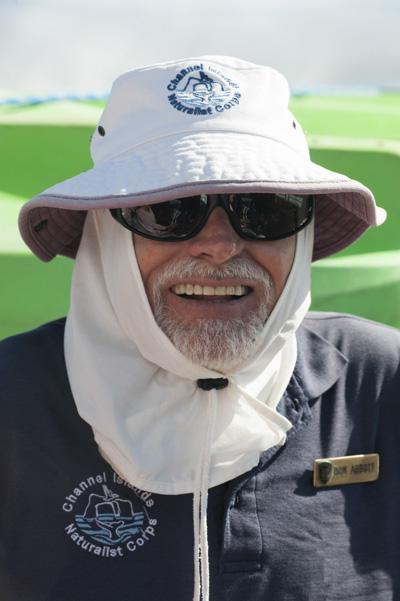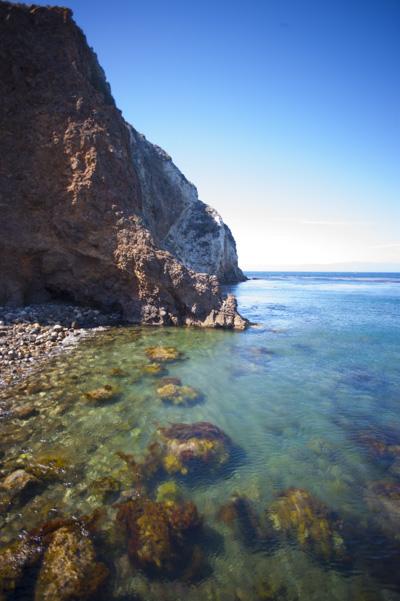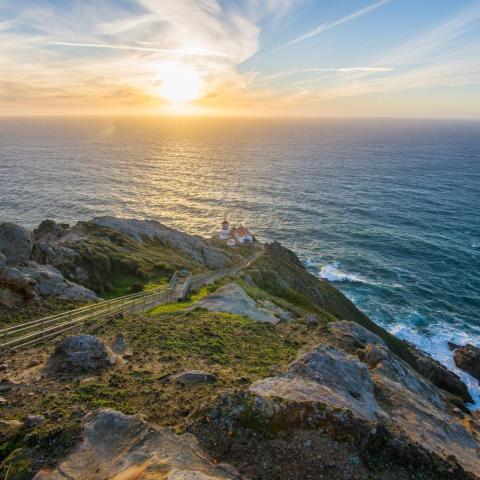
Santa Cruz Island at sunset/Patrick Cone
Imagine a place in Southern California without freeways; a place without strip malls, smog, and millions of people. Imagine an ocean where the golden fish, the Garibaldi, is prolific with hundreds of other species in an underwater forest of kelp beneath wave-battered sea caves. Imagine a place that is still California as it once was, a century ago, with adobe ranch houses, sweeping vistas of cliffs and beach, mountains and valleys, grasslands and cypress groves, and unbelievable quiet.
There still is such a place, and it's called Channel Islands National Park. The five islands that comprise the park lay like a wilderness necklace, stretched across the western horizon, just 20 miles and an hour's boat ride away from the crowded beaches of Santa Barbara and Ventura County. It's a world apart.
The park’s Robert J. Lagomarsino Visitor Center in Ventura Harbor is a great starting point, with its saltwater replica of tidal pools, observation tower, maps, and photographs. On a clear day, the islands are visible to the west, accessible by year-round ferries.

Volunteer Don Abbott/Patrick Cone
Don Abbott, a retired aerospace engineer, is in his 14th year as a park volunteer. He describes these islands as the "American Galapagos" as he rides the Island Packers ferry out towards Scorpion Cove on Santa Cruz Island, the park's largest. The isolation and separation of these islands from the mainland have allowed evolution to proceed independently, with astonishing results. They are home to more than 2,000 plant and animal species, 145 of which are found nowhere else.
Abbott's excitement is contagious as he describes the biodiversity, geology, and archaeology on the islands, from the indigenous Channel Islands fox to the recently extinct Giant Vampire bats and the pygmy mammoth skeletons on Santa Rosa Island that have been excavated. But one of his facts is truly amazing: "The oldest human remains found in North America were found on these islands," he says. "They've been dated at 13,400 years old; older than the 12,000-year-old human bones found on the mainland."
One of the least-visited of all of America's national parks, only 30,000 visitors a year set foot on the islands, and most go to Santa Cruz Island. Five of the eight Channel Islands were set aside by Congress in 1980, after two centuries of private ownership, cattle ranching, farming, and fishing. Santa Cruz Island's management is split between the National Park Service on its eastern end, and The Nature Conservancy, which owns most of the island to the west.
Covering nearly a quarter-million acres, half of which lie beneath the sea (the Channel Islands National Marine Sanctuary extends six nautical miles around the park), the park is mostly undeveloped. Once on the island, there is no transportation available so you'll be walking everywhere you want to go on land, or by kayak or private boat on the water. No bicycles are allowed but recreation opportunities abound, with snorkeling, diving, kayaking, backpacking, hiking, and wildlife watching.
You can take the ferry to Prisoner's Landing (named that in 1830 after 30 convicts where left there), or the more popular Scorpion Landing on Santa Cruz Island. Scorpion hosts a lovely campground beneath a towering grove of eucalyptus trees, just a few minutes' walk from the beach. Once there, you won't hear any generators, smell smoke, or see lines of RVs either: it's a tents only site, with no campfires. It's one of the most peaceful places you will ever spend a night. You'll only hear the hum of the waves, the shriek of the birds, and the wind in the trees. Bald eagles soar over the grassy ridges, watching the sea, having made a comeback from DDT poisoning in the 1900's.
Decades ago, extensive ranching and cultivation nearly devastated these islands, as some 5,000 feral pigs wreaked havoc on the landscape and native fauna. Today, the pigs, and wild goats are gone, and you'll get a chance to observe the stealthy and beautiful Channel Island foxes, which have rebounded from near extinction. But keep an eye on them; they'll invite themselves into your camp if you're not careful.
John "JD" Dresser, a senior guide with Channel Islands Outfitters, leads a long hike from Scorpion to Smuggler's Cove (which got its name in 1920 for a being a popular smuggling stop during Prohibition), where olive groves and old ranch buildings speak to the islands past. But we weren't the first settlers. "It's estimated that there were over 2,000 Chumash Indians here in 1542," says Dresser.
Later, he'll help snorkelers through the kelp forests, pointing out unusual ocean fauna, like the sea potato (which squirts water when threatened), and the translucent sea hare. Schools of bright blue fish swarm throughout the kelp. Then he'll lead a Channel Islands Outfitters kayak tour through the sea caves around Scorpion Cove. You'll have a chance to head into large caverns, and, by timing the swells, exit through small exit tunnels, carved by wind and water. It's an exhilarating experience.

Scorpion Cove is perfect for snorkelers and sea kayaks/Patrick Cone
This is an ocean and island wilderness that is majestic, intimate, beautiful, and powerful, but there are other islands in the park as well. San Miguel Island, to the west, is home to over 100,000 sea lions. And, as evidence of the island's extreme weather, you might see the shipwreck Tortuga, which ran aground on Cardwell Point in 1987, or remnants of a B24 crash from 1943 on Green Mountain.
Closest to the mainland, the sea caves of the cliffy Anacapa Island, with its 1932 lighthouse, are iconic images of the Channel Islands. Santa Rosa Island is almost as large as Santa Cruz Island, while Santa Barbara Island is a mere 639 acres. San Nicolas Island, to the south, is not part of the Channel Islands National Park, but is well-known as the location for the true tale, The Island of the Blue Dolphin, which describes a lone, female, Chumash native inhabitant in the late 1800s.
While those days of exploration are gone, you can still experience the wilderness that was once California by a visit to the Channel Islands.




 Support Essential Coverage of Essential Places
Support Essential Coverage of Essential Places







Add comment